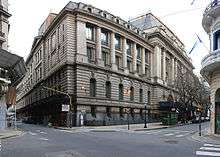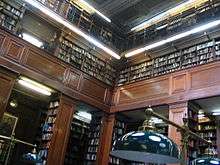Colegio Nacional de Buenos Aires
Coordinates: 34°36′40″S 58°22′26″W / 34.611°S 58.374°W
| Colegio Nacional de Buenos Aires | |
|---|---|
 | |
| Address | |
|
Bolívar 263 Buenos Aires Argentina | |
| Information | |
| Type | Public secondary |
| Established | 1863 |
| Founder | [Bartolomé Mitre] |
| Rector | Prof. Gustavo Zorzoli |
| Gender | Coeducational |
| Enrollment | 2017[1] |
| Colour(s) | Blue and white |
| Athletics | Soccer, field hockey, swimming, handball, track and field, basketball, gymnastics, judo, rugby, volleyball, Fencing |
| Nickname | El Nacional, Nacio |
| Affiliation | University of Buenos Aires |
| Former names | Colegio Grande de San Carlos, Real Colegio de San Carlos, Real Convictorio Carolino, Colegio Nacional |
| Notable alumni | Manuel Belgrano, Bernardo Houssay, Carlos Saavedra Lamas, José Luis Murature, Lalo Schiffrin |
| Website | http://www.cnba.uba.ar |
 | |
Colegio Nacional de Buenos Aires (National School of Buenos Aires) is a public high school in Buenos Aires, Argentina. In the tradition of the European gymnasium it provides a free education that includes classical languages such as Latin and Greek. The school is one of the most prestigious in Argentina. Its alumni include many personalities, including two Nobel laureates and four Presidents of Argentina.
History
Its origins date to 1661, when it was known as Colegio Grande de San Carlos, when the colonial government entrusted the Jesuit Order with the education of the youth. After the Papal suppression of the Jesuits from Spanish Empire-controlled South America in 1767, the institution languished until 1772, when governor Juan José de Vértiz y Salcedo reopened the school as the Real Colegio de San Carlos. Vértiz, already appointed Viceroy of the Río de la Plata, renamed the school Real Convictorio Carolino in 1783, a name that endured until 1806. Thereafter, the school changed its name and program several times.[2]
President Bartolomé Mitre redesignated the institution as the Colegio Nacional in 1863, and since 1911 the school has been administered by the University of Buenos Aires. Originally only for men, the school has admitted women as students since 1957.[2]
Nowadays, students from the Colegio Nacional de Buenos Aires rank among the best in most science Olympiads, such as the IPhO, IChO and IBO.[2]
Alumni
Alumni include many of Argentina's founding fathers, Presidents, members of political parties of all ideologies, internationally recognized scientists, artists, and two Nobel laureates. A partial list includes:
- In the present Macri's Administration: Hernán Lombardi (in charge of Sistema Federal de Medios y Contenidos Públicos), Martín Losteau (ambassador to the USA)
- During the previous Fernandez de Kirchner Administration, government officials: Axel Kicillof (economist, Minister of Economy of Argentina); Alejandro Vanoli (economist, President of the Comisión Nacional de Valores (CNV).[3][4]), Mariano Recalde (Chief Executive Officer of the state-owned airline Aerolíneas Argentinas), Augusto Costa (Secretario de Comercio Interior.), Cecilia Nahón (the Argentina ambassador to the USA).
- Alberto Manguel - writer, bibliophile, essayist, journalist
- Herman Aguinis - business school professor, researcher, author
- Luis Agote - devised the first effective method of blood transfusion
- Roberto Aizenberg - Surrealist painter
- Marcelo Torcuato de Alvear - President of Argentina, 1922-1928
- Mariano Moreno - Independence figure, member of the first independent government of Argentina.
- Manuel Belgrano - leader in the Argentine War of Independence, creator of the national flag
- Miguel Cané - writer, diplomat and lawmaker
- Gregorio de Laferrère - playwright and lawmaker
- Martiniano Molina - chef and elected mayor of Quilmes Partido
- Juan Bautista Egusquiza - President of Paraguay, 1894-1898
- Bernardo Houssay - Nobel laureate in Medicine, 1947
- Agustin P. Justo - President of Argentina, 1932-1938
- Mario Firmenich - Montoneros guerrilla leader
- Alejandro Korn - philosopher and lawmaker
- Ernesto Jaimovich - politician
- Manuel Mendanha - plastic artist
- Film directors: Manuel Antin (founder of the Universidad del Cine), Fabián Bielinsky, Ana Katz, Nicolas Entel (winner Festival de Cine de La Habana)
- Salvador Mazza - epidemiologist who helped control Chagas disease locally
- Father Carlos Mugica - activist priest, assassinated in 1974
- José Pablo Ventura - student activist, assassinated in 1977
- José Luis Murature - Foreign Minister of Argentina, 1914-1916
- Carlos Pellegrini - President of Argentina, 1890-1892
- Ignacio Pirovano - surgeon, performed first local laparotomy
- Nicolás Repetto - co-founder of the Socialist Party of Argentina and Cooperative movement leader
- Carlos Saavedra Lamas - Nobel Peace laureate(1936)
- Roque Sáenz Peña - President of Argentina, 1910-1914
- Lalo Schiffrin - composer and pianist, born Boris Claudio Schifrin, Grammy Award winner and Academy Award nominee
- Bernardo Grinspun - economist, Economy Minister (1983 - 1985)
- Journalists: Pepe Eliaschev (award winning journalist 1945-2014), Martín Caparrós, Rolando Hanglin, Mario Mactas
- Ana María Shua (Shoua)- writer
- Ada María Elflein- Poet
- Alicia Moreau de Justo - political figure, pioneer in women's and human rights.
- Roberto Alemann - lawyer and economist, entrepreneur, antinazi activist, Several times minister of Economy.
- Juan Ernesto Alemann - economist, entrepreneur, antinazi activist, Minister of Economy (1976 - 1981)
- Mario Roberto Álvarez (1913-2011), architect. He designed the municipal Teatro General San Martín (completed in 1960); the Hernandarias Subfluvial Tunnel (completed in 1969), the Colón Opera House's labyrinthine production facilities (1972), the Buenos Aires headquarters for the state steel concern, Somisa (1977), the Salto Grande Dam (1979) and numerous office buildings.
- Cartoonists: Caloi (creator of Clemente), Nik (creator of Gaturro)
- Julio Montaner - AIDS research pioneer
Facilities

The school offers an astronomy observatory, a swimming pool, a cinema, a sports campus with football, rugby, handball, volleyball, hockey and basketball courts. Free classes are available such as astronomy, photography, languages, sailing, tango, theater, history of cinema, Yoga, piano, chess, band production and martial arts.[5] The sailing team has won many of the local competitions. It also has a choir, which sings in the most important school events.
Enrollment
In accordance with the meritocratic conception of the school, admission is highly competitive. It involves ten exams after a year-long course, testing in language, mathematics, geography, and history.[6] Every year 1,200 candidates apply but only around 400 gain admission. There are about 2,000 students enrolled, who pay no fees since the school is public and therefore free.
Building
Designed by French architect Norbert Maillart and opened in 1906, some of the most recognizable features of the French neo-classical building include the two symmetric white marble main staircases, the water fountain in one of the courtyards, the ornately-decorated assembly hall and its organ; and the Colonial-era tunnels that are accessible from the basement, notably from a hidden entrance behind the projection-screen area in the film auditorium.
See also
References
- ↑ Universidad de Buenos Aires, Censo de Estudiantes Secundarios 2004
- 1 2 3 "Colegio Nacional de Buenos Aires" (in Spanish). University of Buenos Aires. Retrieved 2008-10-19.
- ↑ http://www.bcra.gov.ar/institucional/in020301.asp
- ↑ http://drupaldesa.cnba.uba.ar/old/ex-alumnos/busqueda?nombre=Alejandro&apellido=Vanoli&egreso=1979&division=0&profesion=&email=&paginar=20&op=Buscar&form_build_id=form-ef9a271cbe38057c836cf0210dd9f290&form_id=exalumnos_form
- ↑ http://www.cnba.uba.ar/extension/area-cultura/talleres
- ↑ "Descripción del Curso" [Description of the Course]. Curso de Ingreso para los Establecimientos de Enseñanza Media de la UBA (in Spanish). Retrieved 26 November 2013.